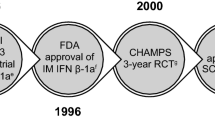Abstract
Human interferon (IFN) β is the first therapeutic agent to convincingly reduce the multiple sclerosis relapse rate and retard disability. To achieve this significant treatment advance over 15 years of preliminary work was necessary, encompassing over 15 controlled trials which employed each of the three human interferons. Important insights into the pathogenesis of multiple sclerosis (MS) were gained, especially from the findings of the single IFN-γ trial. This short history describes the unfolding of our current understanding of the place for IFNs in the management of MS. The contribution of the patients who have participated is recognized and their courage acknowledged. The final role for IFN treatment of MS is unclear, but future studies will be required to define the best IFN, optimal dose, and route of administration and patient selection for long-term management of MS.
Similar content being viewed by others
Author information
Authors and Affiliations
Additional information
Received: 6 June 1996 / Accepted: 8 August 1996
Rights and permissions
About this article
Cite this article
Johnson, K. The historical development of interferons as multiple sclerosis therapies. J Mol Med 75, 89–94 (1997). https://doi.org/10.1007/s001090050093
Issue Date:
DOI: https://doi.org/10.1007/s001090050093




